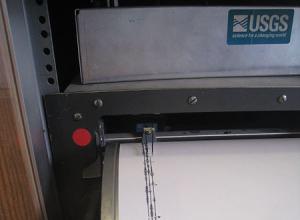Forensic seismologyForensic seismology tested on 2006 munitions depot explosion in Baghdad
Seismometers were developed to record earthquakes, but then they turned out to be useful for monitoring nuclear tests, and now people are using them in all kinds of creative ways. Seismologists could distinguish, mortars, rockets, improvised explosive devices, helicopters, and drones from four miles away. In 2005 and 2006 ten seismometers were installed in northern and northeastern Iraq to study the seismic properties of the Earth’s crust in that area so that it would be possible to quantify the yield of nearby earthquakes or nuclear tests. They proved useful in identifying conventional explosions as well.

Siesmograph captured explosions four miles away // Source: commons.wikimedia.org
On 10 October 2006, a mortar round hit the ammunition supply depot at the U.S. Forward Operating Base Falcon south of Baghdad. The round started a smoldering fire punctuated by whizzing skyrockets, a rain of incandescent fragments, and massive explosions that bloomed into mushroom clouds. Soldiers who videotaped the “cook-off” can be heard wondering what exactly was in the dump and how much longer the explosions would continue.
But the soldiers were not the only ones recording the cook-off: a seismometer just four miles away was also registering every boom and shock. The seismometer was one of ten installed in 2005 and 2006 in northern and northeastern Iraq to study the seismic properties of the Earth’s crust in that area so that it would be possible to quantify the yield of nearby earthquakes or nuclear tests.
The principal investigator on the team that deployed the seismometers was Ghassan I. Aleqabi, a seismic deployment coordinator in the Department of Earth and Planetary Sciences in Arts & Sciences at Washington University in St. Louis. Iraqi in origin, Aleqabi had obtained his Ph.D. in seismology at Saint Louis University and settled in Saint Louis.
WUSTL reports that installing and maintaining instruments in war-torn Iraq was sometimes a hair-raising business. Installation of the seismometer that recorded the cook-off had to be delayed until April 2006 because it was dangerous even to enter the city. And, once deployed, the seismometers, which recorded 100 samples per second, filled their hard drives in a few months, so someone had to return to the sites to bring out the data.
Then the ammunition dump went up. Aleqabi and his colleague Michael Wysession, professor of earth and planetary sciences in Arts & Sciences, were curious and decided to see if the seismometer had recorded the cook-off. “Sure enough, you could see a whole sequence of explosions,” Wysession said.
They report what they found online in the 22 December issue of the Bulletin of the Seismological Society of America. “It was an accident that we got such a rich recording,” Wysession said. “But sometimes science works that way; you get lucky.”
